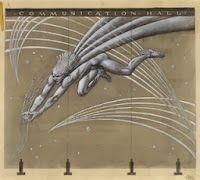 |
| Nebraska State Capitol |
 |
|
One of the bison reliefs designed by
Lee Lawrie for the sides of the parapets at the main entrance to the Capitol |
My topic was the Nebraska State Capitol in Lincoln, built in four stages between 1922 and 1932. Hildreth Meière designed much of the decoration for that building’s interiors, but she was not the primary subject of my presentation. Rather, my objective was to “tell as a whole,” to explain how the team of four assembled by architect Bertram Grosvenor Goodhue, his so-called quadrivirate (Goodhue, Meière, sculptor Lee Lawrie, and architectural iconographer Hartley Burr Alexander), worked together to produce a building with a unified and cohesive theme.
 |
|
The top of the Capitol’s tower with the Thunderbird mosaic
on the drum and The Sower mounted on the dome.
|
Dr. Hartley Burr Alexander, the head of the Philosophy Department at the University of Nebraska, designed the decorative program for the building, which sprang directly from Goodhue’s design—the horizontal base and vertical tower. He provided a philosophical interpretation of these design elements. Lawrie’s sculpture on the building’s exterior progresses from the historical and concrete on the base to the symbolic and abstract at the tower. This same progression is apparent, although in a richer and more complex manner, in Meière’s designs for the interiors.
Lincoln may not be at the top of everyone’s “must see” list, but those who make the pilgrimage are not likely to be disappointed.
 |
| Karen Wagner |
Thanks to Pat Kane of the Yale University Art Gallery for inviting me to speak. And another big thank you to Karen Wagner, the archivist at the Nebraska State Capitol, for guiding me through the Capitol archives and providing digital files of key documents and images of original drawings and sketches.

 Details from the bronze doors designed by Lee Lawrie
Details from the bronze doors designed by Lee Lawrie
 Hildreth Meière’s design of the cosmic sun or central star (left), the source of energy and a symbol of creation, for the marble mosaic floor of the Nebraska State Capitol vestibule.
Hildreth Meière’s design of the cosmic sun or central star (left), the source of energy and a symbol of creation, for the marble mosaic floor of the Nebraska State Capitol vestibule.
 A detail from Vital Energy designed by Hildreth Meière for the marble mosaic floor of the foyer of the Capitol (right).
A detail from Vital Energy designed by Hildreth Meière for the marble mosaic floor of the foyer of the Capitol (right).

 Details from the bronze doors designed by Lee Lawrie
Details from the bronze doors designed by Lee Lawrie Hildreth Meière’s design of the cosmic sun or central star (left), the source of energy and a symbol of creation, for the marble mosaic floor of the Nebraska State Capitol vestibule.
Hildreth Meière’s design of the cosmic sun or central star (left), the source of energy and a symbol of creation, for the marble mosaic floor of the Nebraska State Capitol vestibule.  A detail from Vital Energy designed by Hildreth Meière for the marble mosaic floor of the foyer of the Capitol (right).
A detail from Vital Energy designed by Hildreth Meière for the marble mosaic floor of the foyer of the Capitol (right).

